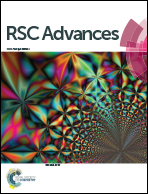Biosynthetic rivalry of o-aminophenol-carboxylic acids initiates production of hemi-actinomycins in Streptomyces antibioticus†
Abstract
Actinomycins consist of two pentapeptide lactone rings attached to 2-amino-4,6-dimethyl-3-oxo-phenoxazine-1,9-dicarboxylic acid (actinocin). The actinocin moiety is formed through oxidative condensation of two 3-hydroxy-4-methylanthranilic acid (4-MHA) pentapeptide lactones (actinomycin halves) as the last step of actinomycin biosynthesis. We found that feeding of 4-MHA or its putative biogenetic precursor 3-hydroxyanthranilic acid (3-HA) to Streptomyces antibioticus induced formation of different new compounds at the expense of actinomycins. These contain only one pentapeptide lactone ring attached to the β-side of their phenoxazinone ring systems and are formed through premature condensation of the externally added abundant 4-MHA or 3-HA with actinomycin halves. They were termed hemi-actinomycins and C-demethyl-hemi-actinomycins, respectively, which differ from each other in the presence or absence of one or both methyl groups in their phenoxazinone moieties. 3-HA also induces synthesis of various C-demethylactinomycins formed through condensation of actinomycin halves in which 3-HA had been incorporated by the 4-MHA incorporating enzyme in lieu of 4-MHA. 3-HA was not converted to 4-MHA as revealed by its inability to stimulate synthesis of actinomycin or hemi-actinomycin synthesis and thus remained a substrate analogue of 4-MHA rather than its precursor. In contrast to S. antibioticus, actinomycin-producing streptomycetes such as Streptomyces chrysomallus or Streptomyces parvulus do not form hemi-structured actinomycins when fed with 3-HA or 4-MHA. They do not possess the enzyme phenoxazinone synthase (PHS) which in S. antibioticus is present and most probably catalyses premature condensation of abundant 4-MHA or 3-HA with actinomycin halves. Testing hemi-acinomycin IV for drug activity revealed that it intercalates into DNA and inhibits relaxation and supertwisting of DNA by topoisomerase I and DNA-gyrase like actinomycin IV (D). Moreover, it has inhibitory activity on growth of Bacillus subtilis.


 Please wait while we load your content...
Please wait while we load your content...